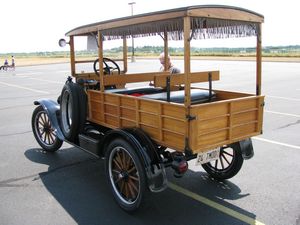
















|
|---|
|
Tail Lights: A Look Ahead at Looking Back Publisher: The Crittenden Automotive Library Byline: Bill Crittenden Date: 4 December 2022 |

 1924 Ford Model T Station Hack, from the era when open cars were still common. The Ford Motor Company was only 21 years old at the time this car was built, and 21 years in the other direction Ford was planning for the return of civilian production at the end of World War II. 1924 Ford Model T Station Hack, from the era when open cars were still common. The Ford Motor Company was only 21 years old at the time this car was built, and 21 years in the other direction Ford was planning for the return of civilian production at the end of World War II.
|
After a rough couple of years, I'm feeling a bit more optimistic about the future of humanity in general lately. Now that the collapse of society feels less imminent, I've been thinking about how amazing this last century and a half of history has been and how it's going to be viewed hundreds of years from now.
Technological progress can only go so far in some areas, and established infrastructure is hard to replace, resulting in an interesting mix of new and old. LED lightbulbs are screwed into E26 sockets that were in use when the first Model T rolled off the assembly line. Depending on the vehicle, Apple CarPlay rides on some mechanical parts that were designed in the 1980s.
No matter what gets added to cars, or if we finally get airless no-flat tires, and we shift to a mostly electric fleet, there will only be one lifetime when technology went from attaching clanky, weak, rudimentary engines to open-top wagons to fully enclosed & air conditioned cars cranked out thousands at a time from massive industrial complexes.
Of course, going from the first powered flight in wood-and-fabric airplane to walking on the moon in 66 years is even more impressive, but I'm trying to keep this mostly about automobiles.
At the beginning of the twentieth century, a "mile-a-minute" pace was something that could only be done by professional drivers in dangerous cars on dedicated race tracks. Now it's known as sixty miles per hour, and it's done with one hand on the wheel and the kids sleeping in the back of the minivan.
Automobile performance reached and exceeded the limits of the human body and reaction times a long time ago. NASCAR topped out at 212 miles per hour and restrictor plates have kept them below that since. IndyCar kept pushing past these limits until Dan Wheldon was killed at Las Vegas Motor Speedway in 2011, and they've been shy about going to big round oval tracks since. Racing series are no longer about pushing the limits of engineering, but pushing the limits of engineering within a rigidly defined and closely monitored envelope. There will never be another era of motor sport like the golden age of the 1960s ever again.
Advancements in computers may one day help us achieve truly self-driving cars, where we can sleep while our cars get us to our destinations more safely than the average licensed driver could, or we can spend the time working or gaming from mobile offices better connected to the world than the brick-and-mortar offices of just a couple decades ago. We're still making incremental improvements in reliability, efficiency, and safety.
But the basic shape and function of highways or vehicles probably isn't going to change much. We have new interchange designs, better lighting, and they're made of more advanced materials but interstates are fundamentally the same as when they were started in the Eisenhower years. Crossovers are more popular than sedans, they've gotten a little bulkier, we've added color changing LED lighting & adaptive cruise control, but the basic shells of cars & crossovers have been consistent since the early 2000s.
So nobody knows specifically what the next thousand years will bring, but it seems safe to predict that teleportation isn't in the foreseeable future and the basic principle of energy efficiency suggests that quadcopter "flying cars" aren't going to replace the rolling wheel and soft tire for most users.
That means that there's only one major developmental age when we decided on standardized controls, the basic range of widths for lanes & vehicles, do we sit towards the middle of the road or the outside, and all of the other little things we take for granted now and are unlikely to change.
Those decisions made during the twentieth century will echo across history for as long as humanity survives, and it's the last era before digital archiving. That's why it's so important to save and scan everything we possibly can.
629.2
The Dewey Decimal System's designation for automobiles falls within the 629.2 range. This section is about Library Owner Bill Crittenden's personal collection of books, magazines, and miscellaneous papers, much of which is available for reference if it's not directly available on CarsAndRacingStuff.com.
As the old saying goes, life comes at you fast. It's been a busier than anticipated month, and I'm only a third of the way through scanning & uploading the text from The Indomitable Tin Goose. Still working on it, though. One of these days things will stay fixed for more than a few weeks and I'll learn to set reasonable goals.
Since the Woodstock Public Library's scanners aren't quite reaching the edge of the pages, I've been looking into building a cheap book cradle for keeping pages flat for photographing them. After the Tucker book's text goes online, I'll see what I can do about getting some shop manual pages online.
This month saw 8 books, 2 event programs, and some collector cards added to the Offline Collection.
History Beyond the Bumpers
The Crittenden Automotive Library includes information from all aspects of automotive transportation and competition. This section highlights interesting topics related to automobiles other than vehicles themselves.
I've often said the difference between hoarding and collecting is organization. It's cleaner, looks better, protects what's being preserved, and you can find a specific item when you want it.
This applies both to physical and digital collections. As I go through all of the previous 50,000+ articles and tweak the indexing lines, I'll also start sorting them out into new niche indices similar to the Hobbies or Stock Car Racing sections. There will soon be sections for Insurance, Electric Vehicles, new continent and country indices, and the state-by-state pages will be moved out of the American Government section and expanded to include everything that's been happening in each state.
This will also help highlight the scope and reach of The Crittenden Automotive Library from the Home Page as new links are added.
Suggestions for new indices are always welcome at admin@CarsAndRacingStuff.com!
About The Crittenden Automotive Library
The Crittenden Automotive Library @ CarsAndRacingStuff.com, based in Woodstock, Illinois, is an online collection of information relating to not only cars, trucks, and motorcycles, but also the roads they drive on, the races they compete in, cultural works based on them, government regulation of them, and the people who design, build, and drive them. We are dedicated to the preservation and free distribution of information relating to all types of cars and road-going vehicles for those seeking the greater understanding of these very important elements of modern society, how automobiles have affected how people live around the world, or for the general study of automotive history and anthropology. In addition to the historical knowledge, we preserve current events for future generations.
The Library currently consists of over 868,000 pages of books, periodicals, and documents, over 54,000 individual articles, more than 18 days of video & 24 days of audio, more than 36,100 photographs & other images, and offline reference materials including 836 book volumes, over 1,100 magazines, and thousands of advertising brochures & documents.
